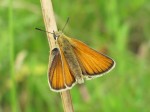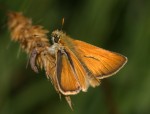The Small Skipper (Thymelicus sylvestris) is a charming faded orange butterfly of the UK countryside, with a black then white margin that fades into the orange of the wings, see image 1. With a wingspan up to 28mm.
As you can see in the photographs below, it is very similar to the Essex Skipper (Thymelicus lineola) and occupies a similar niche, rough grassland-conservation grasslands. The range of this species is also expanding north with climate change, being found as far north as Glasgow and possibly the furthest north for the 3 skippers mentioned, the Moray Firth, Scotland, provided by the National Biodiversity Network (see Is it a moth is it a butterfly? part 1).
- Image 1 Small Skipper Female showing colouration © UK Butterflies Vince Massimo
- Image 2 Yorkshire Fog (Holcus lanatus) showing features
- Image 3 Small Skipper showing the light brown-dull orange on the underside of the antennae © UK Butterflies Vince Massimo
- Image 4 The Small Skipper showing the large sex brand © UK Butterflies Peter Eeles
The 3 skipper species on campus all hold their wings open in the “half open posture”. The Small Skipper has one generation a year but this species may be seen in June, July and August. The caterpillar food plant differs from that of the Essex Skipper as it is mainly Yorkshire Fog (Holcus lanatus) see image 2 but False Brome (Brachypodium sylvaticum) and Timothy (Phleum pratense) may also be used. The species lays its eggs in the dead furled leaf stems finding suitable openings, where a row of several eggs can be laid. The caterpillar then develops in the egg over approximately 3 weeks and hatches, it then spins a silken cocoon around itself before hibernating until the spring. The following spring it emerges and (as with the Essex Skipper) forms a tube between the edges of a leaf blade, from which it emerges to feed. The caterpillar has 5 instars in all, with 4 moults before pupation.
Identification is possible for males and females but key to identifying the species from the superficially similar Essex Skipper, is the antennae. The antennae-tip underside on a Small Skipper is always light brown to a dull orange see image 3 whereas a Essex Skipper’s antennae-tip below is always black, as if dipped in black paint. Between males and females the distinctive feature is the sex brand, (a black line on the forewing) see image 4, only present in males. This is larger on male Small Skippers than the male Essex Skippers. The sex brand being formed of a line of scent scales, the same as the Essex Skipper, to attract females.
Sites you may wish to visit are:
http://www.butterfly-conservation.org/
http://www.ukbutterflies.co.uk/index.php
http://www.hantsmoths.org.uk/index.htm
Please record any sighting seen on campus, including the date, in the comments section below for assessment by subsequent authors.
We thank photographers from UK Butterflies for permission to use their images. Individual credits are given with each image.




